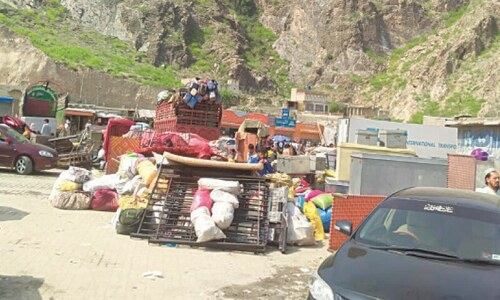CHITRAL: Though the freezing cold in Chitral’s northernmost belts located at an altitude of over 8,000 feet confine animals to corrals in villages, yaks keep grazing in pastures under the open sky even during snowfall.
The Baroghil, Yarkhoon Lusht, Khot and Laspur villages located in the foothills of Hindu Kush system of mountains in Upper Chitral have high concentration of yak population. The villages have large tracts of pastures but agricultural activities are not possible there due to adverse climatic conditions.
Yaks are the size of common cows but they have many peculiarities, which made them distinct from other beasts of the ilk enhancing their price. They are adapted only to the higher pastures of altitudes above 8,000 feet above sea level.
Mohammad Yousuf Shahzad of Laspur valley told Dawn that the price of a milch cow was around Rs60,000, while yak’s was over 0.1 million.
He said yaks didn’t like to be confined to closed places and they grazed in the pastures like other wild animals throughout the year in the vicinity of villages.
The resident said following the start of the winter season and the first snowfall of the year, the yaks tended to the lower altitudes near the villages in search of food and security from predators.
“The double layer of hair on their body and specially structured hooves help yaks brave the intense cold during the winter season when their habitats receive more than four feet of snow. They pass the night in the open during snowfall as their body temperature doesn’t allow the accumulation of snow on their body. They remove snow to find food in the ground and wade to the nearby stream to quench their thirst,” he said.
The resident said no yak had ever perished due to the intense cold as their body had been structured to offer resilience to intense cold that was the special characteristic of the animal, while hook-shaped horns protected yaks from wild beasts like wolfs and leopards.
Mr Shahzad said the milch yak grazing in the pasture did return home once a day to suckle its calf, which was kept in corrals for one year after birth.
He said the yaks were a source of livelihood for the residents of high-altitude villages, where farming wasn’t possible due to climatic conditions.
“The raising of yak has become the main source of earning hard cash for the residents to purchase commodities of daily life,” he said.
Baroghil valley has a large number of yaks, where they’re also used as beast of burden and riding. The local people herd some of their yaks to the nearby markets in Chitral and Gilgit-Baltistan once a year, where they are sold for hard cash.
Published in Dawn, November 26th, 2019












































